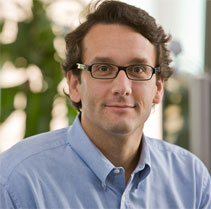Researchers Question Effectiveness of U.S. Patent System
By Sherry Main
Irvine, Calif., July 9, 2009 -- A new study published in The Columbia Science and Technology Law Review challenges the traditional view that patents foster innovation, suggesting instead that patents may harm new technology, economic activity and societal wealth. These results may have important policy implications because many countries count on patent systems to spur new technology and promote economic growth.
To test the hypothesis that patent systems promote technological innovation, Calit2 affiliate Bill Tomlinson, associate professor of informatics, and research partner Andrew Torrance of the University of Kansas School of Law, developed an online simulation game of the patent system they call PatentSim. Their results suggest that a patent system underperforms a "commons," in which no patent protection is available, on several important measures. Although these surprising results call into question traditional justifications for patent systems, they do align with the increasingly well-supported notion that user and open innovation can succeed where patents may fail.
The server, in turn, draws from a database of locations and environmental features and, depending on the module the user selects and command s/he gives, provides voice-based guidance (using an interactive Voice Response system) specifying the direction in which to head and the distance in meters to the destination. Directions can be given once or updated on demand to reflect the user's progress between waypoints along the path to the destination.
|
||||
PatentSim uses an abstract model of the innovation process, a database of potential innovations, and a network over which users may interact with one another to license, assign, buy, infringe and enforce patents. PatentSim allows users to simulate the innovation process in one of three scenarios: a patent system, a “commons” system with no patents, or a system with both patents and open source protection.
“In PatentSim, we found that the patent system did not work to spur innovation,” says Tomlinson. “In fact, participants were more likely to innovate when there was no intellectual property protection at all, or when they could open source their innovations and share them with other people.”
The researchers measured the efficacy of the patent system based on 1) innovation – the number of unique inventions; 2) productivity – a measure of economic activity; and 3) societal wealth – the ability to generate money.
The subjects of the simulation game were first-year law students who had never had any intellectual property coursework. Torrance and Tomlinson have plans to conduct further simulations with subjects of different backgrounds, including MBA students at Harvard.
“Current patent laws are based on assumptions that patents spur technological progress; those assumptions were considered settled more than a century ago and few have questioned them since then,” says Torrance. “If it turns out that our laws are based upon misinformation and bad assumptions, society may be failing to promote beneficial new technologies that could improve potential quality of life.”
The full paper, “Patents and the Regress of Useful Arts,” is currently ranked in the top ten recently uploaded publications in Law & Economics on the Social Science Research Network Web site, the leading social sciences scholarly publication database, and is available for free download at : http://papers.ssrn.com/abstract=1411328 .



